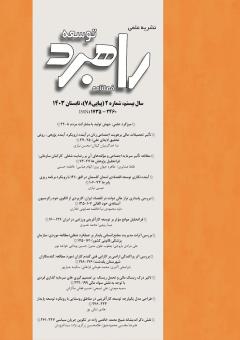بررسی پایداری تراز مالی دولت در اقتصاد ایران: کاربردی از الگوی خود رگرسیون آستانهی خود القائی
محورهای موضوعی :
فاطمه همایونی
1
,
داود محمودی نیا
2
![]()
1 - دانشگاه ولی عصر (عج)
2 - دانشگاه ولی عصر (عج)
کلید واژه: واژگان کلیدی: پایداری مالی, بدهی دولت, کسری بودجه, تراز مالی, بازی پونزی و مدل SETAR. ,
چکیده مقاله :
چكيده اگر دولت برای تأمین کسری بودجهی خود، قرضگیرندهی همیشگی شود و همواره وام قدیم را با قرض جدید تأمین مالی نماید، وارد بازی پونزی میشود. در واقع انباشت کسری بودجه منجر به بدهی بیشتر دولت میشود تا جایی که بحران بدهی شکل گرفته و دولت قادر به تأمین مخارج خود نمیباشد؛ بنابراین پایداری مالی ناظر بر مفهوم «بدهی و پایداری آن» است. برای پیشگیری از چنین شرایطی، سیاست مالی باید به گونهای تنظیم شود که امکان بازپرداخت بدهی دولت را فراهم نماید؛ یعنی پایدار باشد. در این پژوهش به تخمین تابع تراز مالی دولت ایران در رژیمهای مالی پایدار و ناپایدار در قالب مدل SETAR طی سالهای 1350 تا 1399 پرداخته شده است .نتایج حاصل از پنج برازش مختلف در چارچوب مدل SETAR نشان داد که متغیر نسبت بدهی به تولید ناخالص داخلی به عنوان «متغیرآستانهای» دارای تأثیر منفی بر تراز مالی است؛ در حالی که متغیر غیرآستانهای رشد تولید ناخالص داخلی دارای تأثیرگذاری مثبت بر تراز مالی طی رژیمها بوده است. از دیگر نتایج مهم به دست آمده این است که تراز مالی بالا لزوماً به معنای پایداری سیاستهای مالی نمیباشد.
Davoud Mahmoudinia Fateme Hoomayoni Kholari Abstract If the government becomes a permanent borrower to cover its budget deficit and always finances the old loan with a new loan, it enters the Ponzi game. In fact, the accumulation of budget deficit leads to more government debt to the point where a debt crisis is formed and the government is unable to meet its expenses; Therefore, financial sustainability refers to the concept of "debt and its sustainability". In order to prevent such situations, the financial policy should be adjusted in such a way as to provide the possibility of repaying the government's debt; It means to be sustainable. In this research, the estimation of the financial balance function of the government of Iran in sustainable and unsustainable financial regimes in the form of SETAR model during the years 1971 to 2020 has been done. For this purpose, the financial balance was estimated as a dependent variable and according to the common approach in assessing financial sustainability, the ratio of debt to GDP of the previous period was used as the determining factor of the regime. The results of five different fits within the framework of the SETAR model showed that the debt-to-GDP ratio variable as a "threshold variable" has a negative effect on the financial balance; While the non-threshold variable of GDP growth has had a positive effect on the financial balance during the regimes. Also, the absolute value of the first lag coefficient of the debt-to-GDP ratio variable is significantly higher in the unsustainable regime than in the sustainable regime. Another important result is that a high financial balance does not necessarily mean the sustainability of financial policies.
